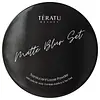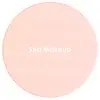What's inside
What's inside
 Key Ingredients
Key Ingredients

 Benefits
Benefits

 Concerns
Concerns

 Ingredients Side-by-side
Ingredients Side-by-side

Talc
AbrasiveAluminum Starch Octenylsuccinate
AbsorbentMethyl Methacrylate Crosspolymer
Hydrated Silica
AbrasiveNylon-12
Diisostearyl Malate
EmollientIsononyl Isononanoate
EmollientSqualane
EmollientPhenoxyethanol
PreservativeCI 77891
Cosmetic ColorantSalicylic Acid
MaskingTocopheryl Acetate
AntioxidantGlycerin
HumectantCI 77492
Cosmetic ColorantButylene Glycol
HumectantEthylhexylglycerin
Skin ConditioningMelaleuca Alternifolia Leaf Oil
AntioxidantWater
Skin ConditioningCI 77491
Cosmetic ColorantCentella Asiatica Leaf Extract
Skin ConditioningRice Bran/Germ Triterpenoids
Skin ConditioningBioflavonoids
Skin ConditioningSesame Amino Acids
HumectantCI 77499
Cosmetic ColorantAluminum Hydroxide
EmollientHydrogen Dimethicone
Triethoxycaprylylsilane
Talc, Aluminum Starch Octenylsuccinate, Methyl Methacrylate Crosspolymer, Hydrated Silica, Nylon-12, Diisostearyl Malate, Isononyl Isononanoate, Squalane, Phenoxyethanol, CI 77891, Salicylic Acid, Tocopheryl Acetate, Glycerin, CI 77492, Butylene Glycol, Ethylhexylglycerin, Melaleuca Alternifolia Leaf Oil, Water, CI 77491, Centella Asiatica Leaf Extract, Rice Bran/Germ Triterpenoids, Bioflavonoids, Sesame Amino Acids, CI 77499, Aluminum Hydroxide, Hydrogen Dimethicone, Triethoxycaprylylsilane
Talc
AbrasiveSilica
AbrasiveCetyl Ethylhexanoate
EmollientBoron Nitride
AbsorbentNylon-12
Triethoxycaprylylsilane
Salicylic Acid
MaskingWater
Skin ConditioningPhenoxyethanol
Preservative1,2-Hexanediol
Skin ConditioningEthylhexylglycerin
Skin ConditioningMethylpropanediol
SolventHamamelis Virginiana Extract
AntiseborrhoeicHydroxyacetophenone
AntioxidantHexylene Glycol
EmulsifyingIngredients Explained
These ingredients are found in both products.
Ingredients higher up in an ingredient list are typically present in a larger amount.
Ethylhexylglycerin (we can't pronounce this either) is commonly used as a preservative and skin softener. It is derived from glyceryl.
You might see Ethylhexylglycerin often paired with other preservatives such as phenoxyethanol. Ethylhexylglycerin has been found to increase the effectiveness of these other preservatives.
Nylon-12 is a polymer. It is derived from 12-aminododecanoic acid, an omega-amino fatty acid
According to a manufacturer, it is a talc substitute. Like talc, nylon-12 gives products a satin feel. The manufacturer also claims this ingredients does not block pores and has moderate oil absorption.
This ingredient may not be reef-safe.
Learn more about Nylon-12Phenoxyethanol is a preservative that has germicide, antimicrobial, and aromatic properties. Studies show that phenoxyethanol can prevent microbial growth. By itself, it has a scent that is similar to that of a rose.
It's often used in formulations along with Caprylyl Glycol to preserve the shelf life of products.
Salicylic Acid (also known as beta hydroxy acid or BHA) is a well-known ingredient for treating skin that struggles with acne and clogged pores. It exfoliates both the skin's surface and deep within the pores to help clear out buildup, control oil, and reduce inflammation.
Unlike AHAs (alpha hydroxy acids), salicylic acid is oil-soluble. This allows it to penetrate into pores which makes it especially effective for treating blackheads and preventing future breakouts.
Salicylic acid is also known for its soothing properties. It has a similar structure to aspirin and can calm inflamed or irritated skin, making it a good option for acne-prone skin that is also sensitive.
Concentrations of 0.5-2% are recognized by the U.S. FDA as an over-the-counter topical acne product.
It can cause irritation and/or dryness if one's skin already has a compromised moisture barrier, so it's best to focus on repairing that before introducing this ingredient into your routine.
While salicylic acid does not increase sun sensitivity, it’s still important to wear sunscreen daily to protect your skin.
If you are looking for the ingredient called BHA or Butylated Hydroxyanisole, click here.
Learn more about Salicylic AcidTalc is a clay mineral. It helps absorb moisture and improve the texture of products. Like other types of clay, Talc can have a slight exfoliating effect on skin. Talc can be added to increase the volume of products.
Some Baby powders are made by combining talc with corn starch. The word "talc" comes from Latin and originates from Arabic. Talc is a mineral commonly found throughout the world.
If you have any concerns about using talc, we recommend checking out the FDA's official page.
Learn more about TalcTriethoxycaprylylsilane is a silicone used to bind and stabilize ingredients.
As an emulsifier, it helps prevent ingredients from separating. This can help elongate the shelf life of products.
Triethoxycaprylylsilane is often used to coat mineral sunscreens ingredients to help give a better feel. It also helps reduce oxidative stress in sunscreens.
Learn more about TriethoxycaprylylsilaneWater. It's the most common cosmetic ingredient of all. You'll usually see it at the top of ingredient lists, meaning that it makes up the largest part of the product.
So why is it so popular? Water most often acts as a solvent - this means that it helps dissolve other ingredients into the formulation.
You'll also recognize water as that liquid we all need to stay alive. If you see this, drink a glass of water. Stay hydrated!
Learn more about Water